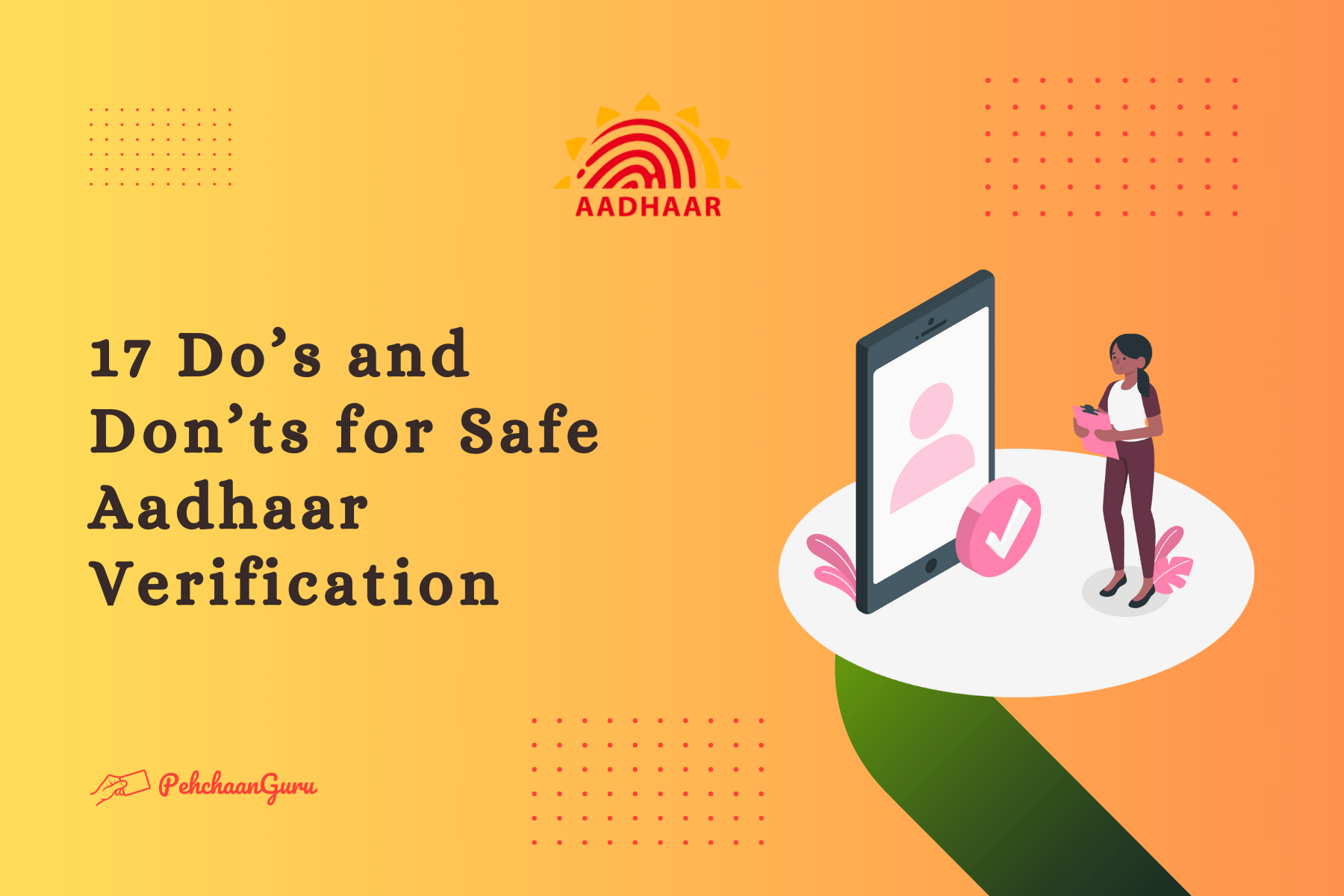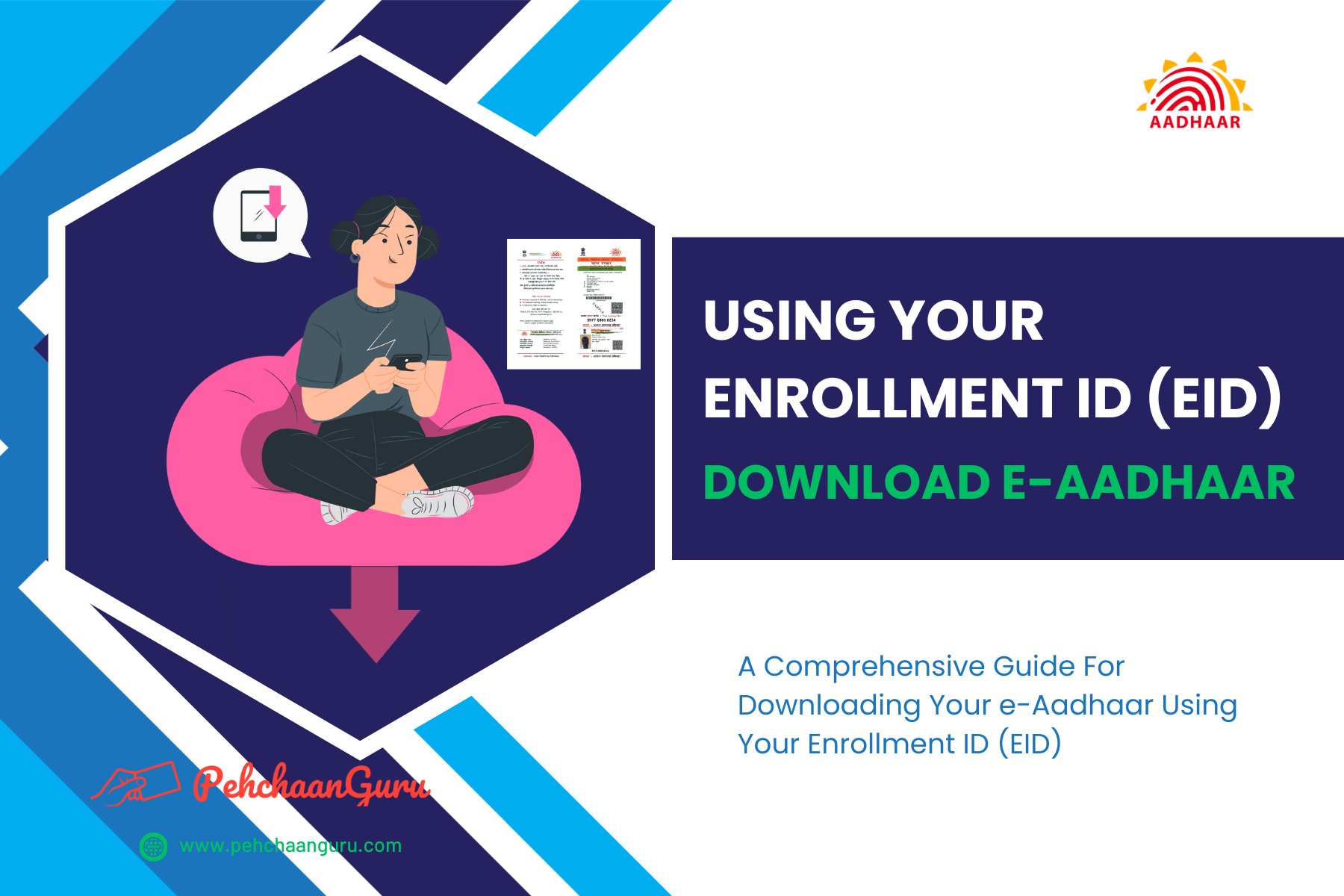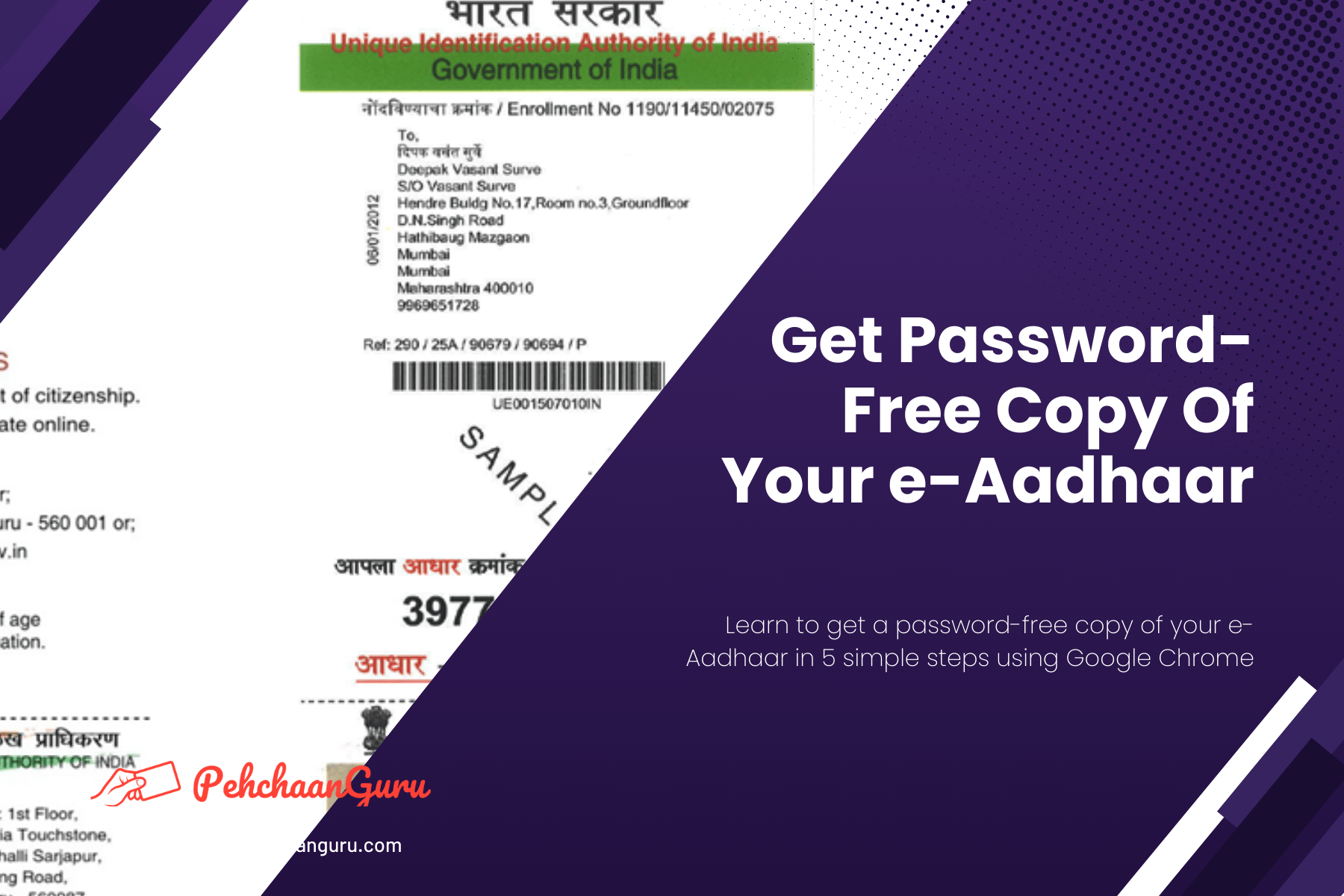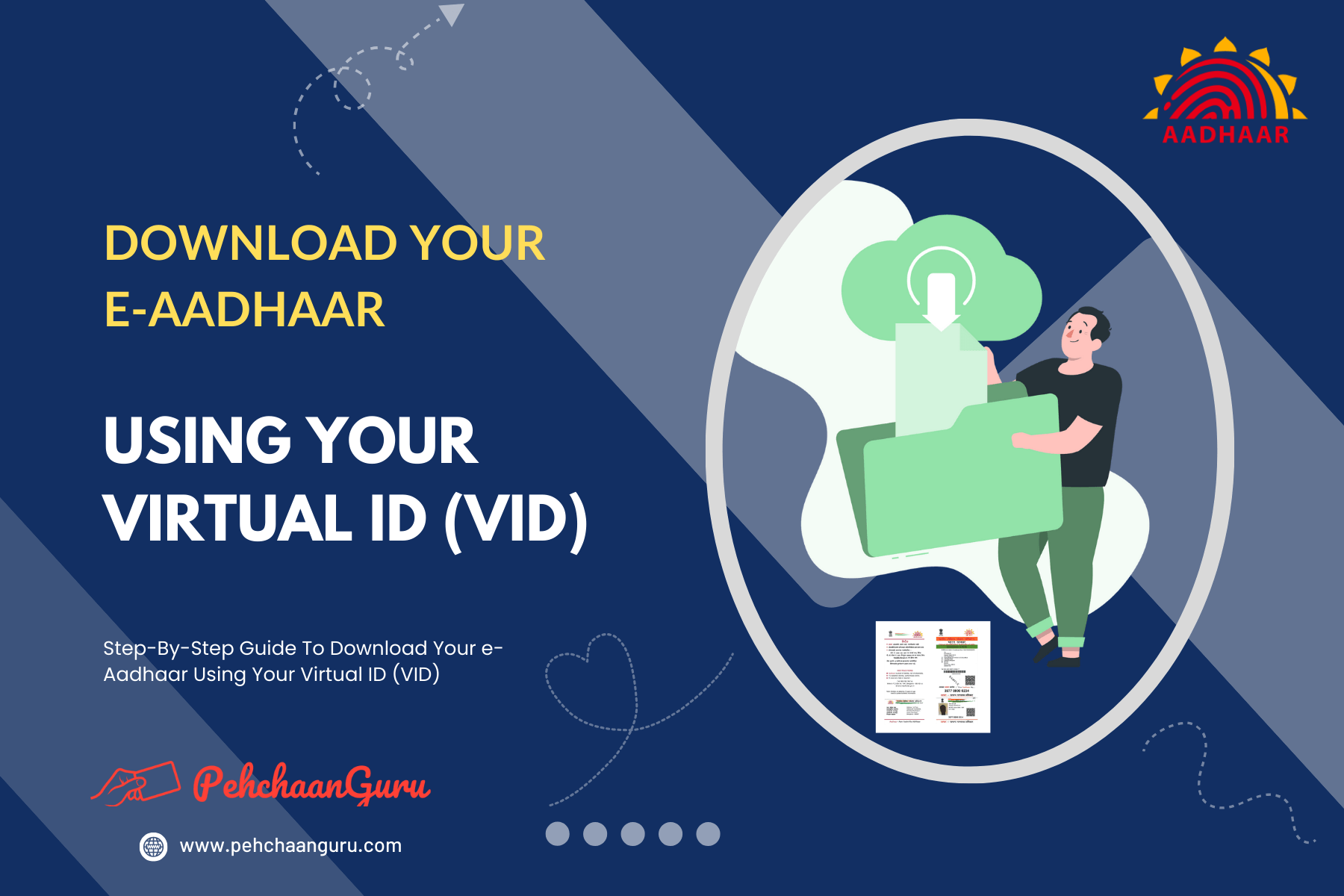Table Of Contents
ToggleIntroduction
In today’s digital world, Aadhaar has become a very important identity card for people in India. The Unique Identification Authority of India (UIDAI) issues Aadhaar, and it’s a single way to prove who you are, whether it’s online or offline. This 12-digit number comes with lots of benefits, like access to more than 1700 government services, banking, telecom services, and more.
UIDAI uses advanced technology to make sure that using Aadhaar is safe, easy, and fast. There are laws, like the Aadhaar Act and its rules, that require organizations to handle and store your Aadhaar number safely and follow the rules.
But, as they say, “with great power comes great responsibility.” When you share your Aadhaar number, it’s important to be careful and follow specific rules. This guide gives you all the information you need to use Aadhaar safely, protect your digital identity, and confidently use Aadhaar for different purposes.
The 10 Do's of Aadhaar Usage
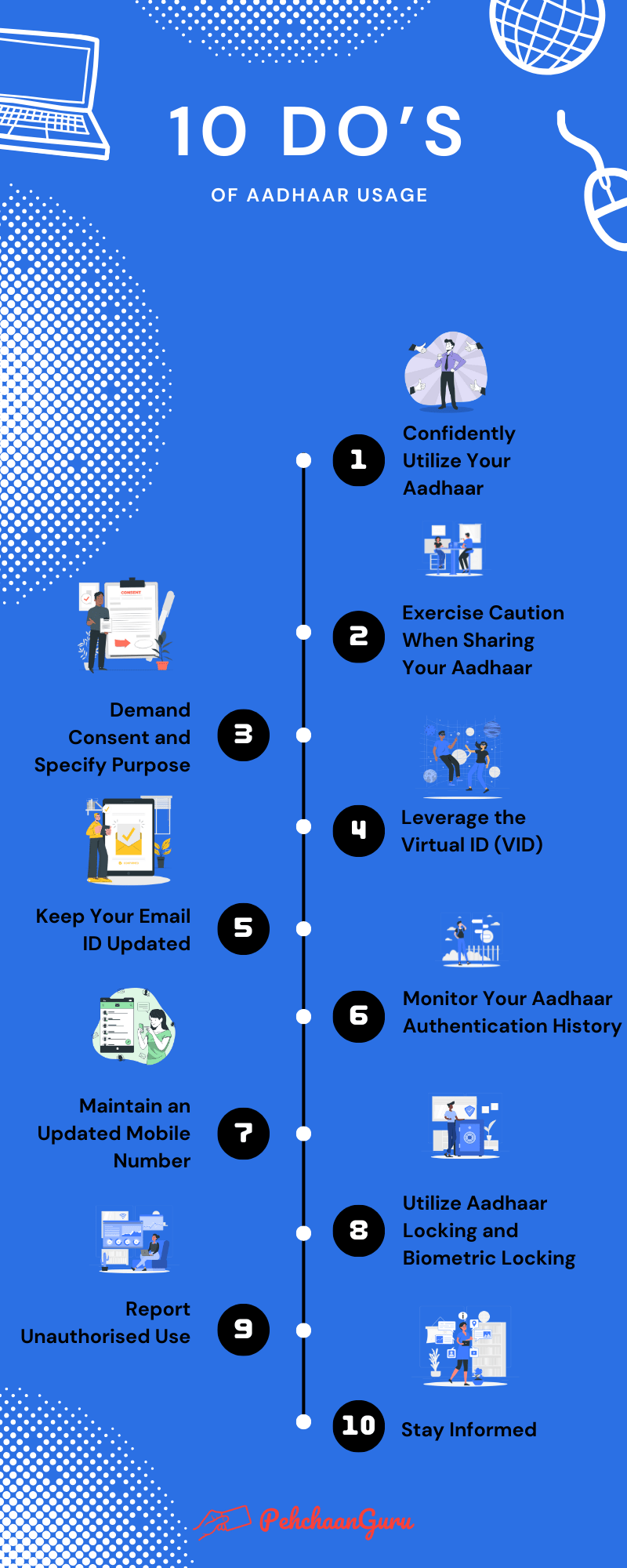
01 Confidently Utilize Your Aadhaar
Make Aadhaar your go-to digital identity card. Whenever there’s a need to verify your identity, have confidence in using it. It’s your secure key to confirming who you are in various situations. So, embrace Aadhaar as your trusted means of identification and use it whenever necessary.
02 Exercise Caution When Sharing Your Aadhaar
Treat your Aadhaar information with the same level of care and discretion as you do with other sensitive personal data like your mobile number, bank account details, or essential identity documents such as Passports, Voter IDs, PAN Cards, or Ration Cards.
Just as you wouldn’t casually share your bank account information with strangers, it’s essential to maintain a similar level of caution with your Aadhaar details. Your Aadhaar holds valuable personal information, and mishandling it can have serious consequences. So, safeguard it diligently, share it only when necessary, and verify the authenticity of the requesting entity. By doing so, you’ll help ensure the security of your identity and protect yourself from potential misuse of your Aadhaar data.
03 Demand Consent and Specify Purpose
It’s crucial to insist that any organization or individual requesting your Aadhaar number must first obtain your consent. Furthermore, they should provide a clear and specific explanation of why they need it, ensuring complete transparency and accountability in the process.
Your Aadhaar information is sensitive, and you should always have a clear understanding of why it is being collected and for what purpose. This not only safeguards your privacy but also helps prevent misuse of your Aadhaar data for unauthorized activities. By advocating for transparency and accountability in Aadhaar usage, you contribute to a safer and more secure digital environment for everyone.
04 Leverage the Virtual ID (VID)
If you have reservations about sharing your Aadhaar number, consider utilizing the Unique Identification Authority of India’s (UIDAI) Virtual ID(VID) option. The VID serves as a secure alternative to your Aadhaar number when undergoing authentication processes.
One of the significant advantages of VID is that you can change it daily, which enhances your security significantly. Following the minimum validity period, currently set at one calendar day or after midnight (12 AM), Aadhaar number holders have the option to request the generation of a fresh VID. This process results in the creation of a new VID, while the previous VID becomes deactivated.
This feature ensures that you maintain a higher level of privacy and security while still benefiting from the convenience of Aadhaar-based authentication. By using VID, you have more control over who has access to your Aadhaar details and reduce the risk of unauthorized or unnecessary Aadhaar number sharing. It’s a valuable tool for protecting your identity in the digital world.
For a more comprehensive understanding, you can explore our blog post on generating a VID.
05 Monitor Your Aadhaar Authentication History
Make it a habit to regularly review your Aadhaar authentication history, covering the previous six months. You can conveniently do this through either the UIDAI website or the m-Aadhaar mobile app. This practice is essential as it allows you to promptly detect any unauthorized attempts to access or use your Aadhaar details.
By keeping an eye on your authentication history, you stay vigilant against potential security breaches or misuse of your Aadhaar data. If you notice any suspicious or unfamiliar entries, you can take immediate action to secure your identity and report any unauthorized activities to the appropriate authorities. This proactive approach helps ensure the safety and integrity of your Aadhaar information in an ever-evolving digital landscape.
For a more in-depth understanding, please read our blog post regarding Aadhaar authentication history. This post covers topics such as what it entails, where to locate it, and how to effectively monitor it.
06 Keep Your Email ID Updated
Enhance your Aadhaar security by linking it to your current and regularly monitored email ID. This practice ensures that you receive email notifications from the Unique Identification Authority of India (UIDAI) each time your Aadhaar number is utilized for authentication.
By staying connected to your email, you can promptly become aware of any Aadhaar-related activity, allowing you to verify its legitimacy and take immediate action in case of any suspicious or unauthorized access attempts. This added layer of security not only keeps you informed but also empowers you to maintain control over your Aadhaar data, reducing the risk of identity theft or misuse. Regularly checking your email notifications is a simple yet effective way to safeguard your digital identity.
If your email ID is not linked to Aadhaar or if you wish to update your email ID in Aadhaar, kindly read our blog for a detailed step-by-step guide on how to proceed with the update.
07 Maintain an Updated Mobile Number
Numerous services depend on OTP-based Aadhaar authentication, where a one-time password is sent to your registered mobile number to verify your identity. Ensuring that your mobile number on your Aadhaar profile is up-to-date is vital for hassle-free access to these services.
Having an accurate and current mobile number linked to your Aadhaar ensures that you receive OTPs promptly, making the authentication process swift and secure. It’s crucial to keep this information updated, as an incorrect or outdated mobile number can lead to authentication failures, potentially causing inconvenience when accessing essential services or conducting important transactions. By maintaining an updated mobile number, you can enjoy the full benefits of Aadhaar’s convenience and security in various applications.
In case your mobile number is not linked to Aadhaar or if you wish to update your mobile number in Aadhaar, please refer to our blog for a comprehensive, step-by-step guide on how to initiate the mobile number update process in Aadhaar.
08 Utilize Aadhaar Locking and Biometric Locking
To bolster your security measures, make use of UIDAI’s feature that enables you to lock your Aadhaar or biometric information when you’re not actively using it. This lock can be swiftly and easily unlocked whenever necessary. Locking your Aadhaar or biometrics adds an extra layer of protection against unauthorized access or misuse of your identity.
It’s especially valuable in situations where you’re not immediately using your Aadhaar, such as when it’s stored digitally on your device, or for added peace of mind when you’re not actively using Aadhaar-based services. By taking advantage of this feature, you have more control over who can access your Aadhaar information, further enhancing your overall security and privacy.
If you are interested in understanding the process of locking or unlocking your Aadhaar or its biometrics, you can read our in-depth blog post that provides comprehensive guidance on this topic.
09 Report Unauthorized Use
If you ever have concerns about potential unauthorized use of your Aadhaar or if you simply have questions related to Aadhaar, don’t hesitate to contact UIDAI. You can reach them through their toll-free helpline at 1947, which is available around the clock, or by sending an email to [email protected].
Your vigilance and proactive approach play a crucial role in enhancing the security of the Aadhaar system. By reporting any suspicious activities or seeking clarification when in doubt, you not only protect your own identity but also contribute to the overall safeguarding of the Aadhaar ecosystem. UIDAI is there to assist you and address any concerns you may have, ensuring that Aadhaar continues to be a secure and reliable tool for identity verification.
10 Stay Informed
To remain informed about the latest updates, developments, and changes related to Aadhaar, consider following UIDAI on their various social media platforms, such as Facebook, Twitter, Instagram, LinkedIn, Youtube, and Koo. These platforms are valuable sources of information and can keep you up to date with any announcements, news, or important modifications regarding Aadhaar.
By staying connected with UIDAI through social media, you gain direct access to authoritative and timely information. This can be especially beneficial when it comes to understanding new features, security measures, or any changes in policies related to Aadhaar. It’s a proactive way to ensure that you’re well-informed and can make the most of your Aadhaar while staying updated on any developments that may affect you.
The 7 Don'ts of Aadhaar Usage
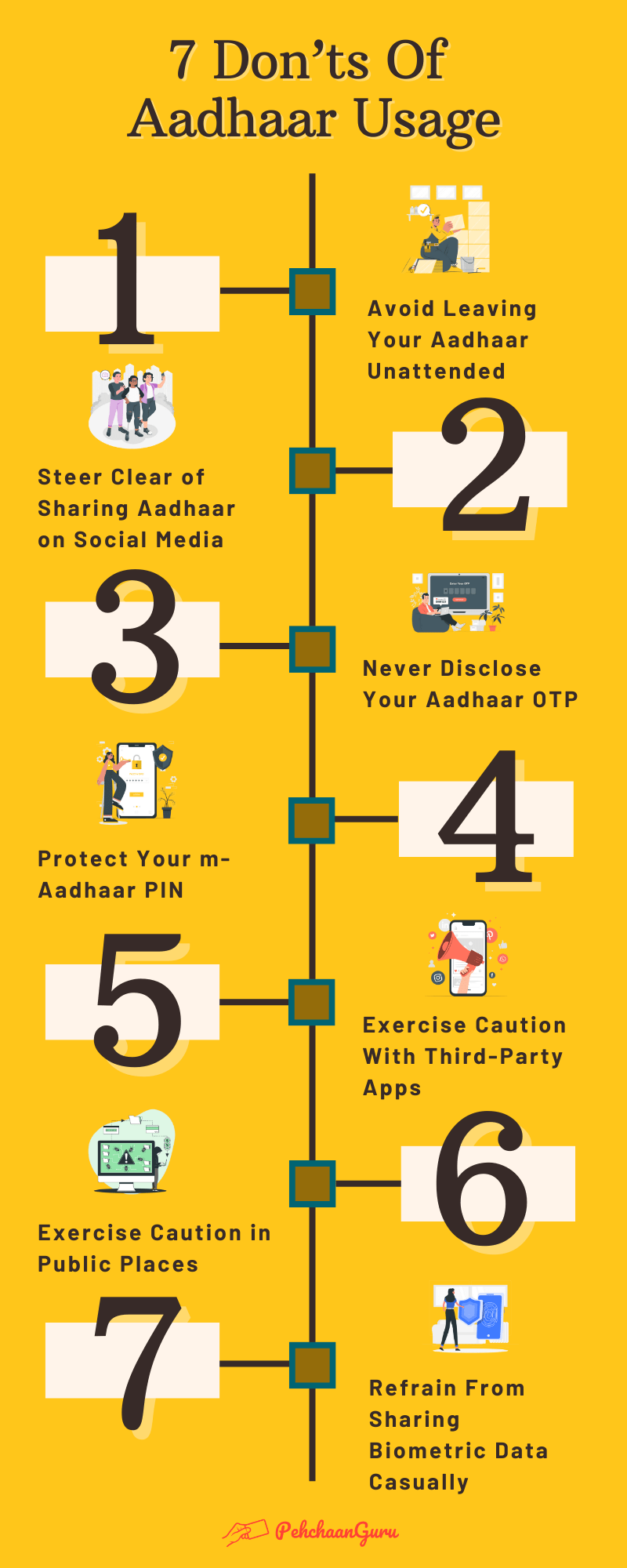
01 Avoid Leaving Your Aadhaar Unattended
Take special care of your Aadhaar documents, whether it’s the Aadhaar letter, PVC card, or any photocopies. Make sure they are never left unattended or accessible to unauthorized individuals. These documents contain sensitive information and are essential for various identity verification purposes.
Losing them or allowing them to fall into the wrong hands can pose a significant security risk. Store them in a secure place, much like you would with important identification documents, to prevent any potential misuse. Your diligence in safeguarding these materials contributes to the overall security of your digital identity and helps protect you from identity theft and fraud.
02 Steer Clear of Sharing Aadhaar on Social Media
It’s absolutely crucial never to openly share your Aadhaar number on social media platforms such as Twitter, Facebook, Instagram, or any other public forums. Maintaining the strict confidentiality of your Aadhaar is paramount for safeguarding your identity. Sharing your Aadhaar openly on social media can expose you to various risks, including identity theft and fraud.
It’s essential to treat your Aadhaar details with the same level of confidentiality as your other sensitive personal information. Only provide your Aadhaar number when required for legitimate and authorized purposes, and always exercise caution to ensure that it remains private and secure. By following these precautions, you significantly reduce the chances of your identity being misused or compromised.
03 Never Disclose Your Aadhaar OTP
Your Aadhaar OTP (One-Time Password) is a critical component in verifying your identity securely. It’s crucial to treat it with the utmost care and never share it with unauthorized individuals or entities. Sharing your Aadhaar OTP with anyone other than authorized and trustworthy sources can jeopardize your security and potentially lead to misuse of your Aadhaar information.
Think of your Aadhaar OTP as a digital key that unlocks access to your identity. Protecting it ensures that only you or trusted parties can use it for legitimate purposes. Exercise caution when sharing your OTP, and do so only when necessary and with entities you trust. By safeguarding your Aadhaar OTP, you take a significant step in preserving the security and integrity of your digital identity.
04 Protect Your m-Aadhaar PIN
Your m-Aadhaar PIN is a confidential piece of information that should be stored securely and kept confidential at all times. It is a crucial element in ensuring the security of your digital identity. Under no circumstances should you share your m-Aadhaar PIN with anyone, as doing so can potentially grant unauthorized access to your personal information and Aadhaar-related services.
Think of your m-Aadhaar PIN as a lock that safeguards your digital identity. By keeping it to yourself and not disclosing it to others, you maintain control over who can access your Aadhaar information and conduct transactions on your behalf. This simple yet vital precaution helps prevent identity theft, fraud, and other security risks associated with unauthorized access to your m-Aadhaar profile.
05 Exercise Caution with Third-Party Apps
It’s essential to exercise caution when using third-party mobile apps that request Aadhaar authentication. Before proceeding, take a moment to verify the authenticity of the app and ensure that it has obtained proper authorization from UIDAI (Unique Identification Authority of India). Using unverified or unauthorized apps for Aadhaar-related transactions can be risky, as it may compromise the security of your personal information.
Always double-check the legitimacy of the app by confirming its UIDAI authorization, which adds an extra layer of assurance that your data will be handled securely and in compliance with regulations. This prudent approach helps protect your Aadhaar information from potential misuse and ensures that your identity remains safeguarded while using third-party services.
06 Exercise Caution in Public Places
When you find yourself in public places like cybercafés or public computers and need to share your Aadhaar information, it’s crucial to exercise heightened vigilance to prevent unauthorized access. Public computers may not have the same security measures as your personal devices, making them potentially risky for handling sensitive information like Aadhaar. Be cautious of prying eyes or individuals trying to peek at your screen while you enter Aadhaar details.
It’s advisable to shield your screen and keyboard when inputting this information, ensuring that it remains private. Additionally, always log out and clear any saved data or passwords after using public computers to minimize the risk of unauthorized access to your Aadhaar information. By taking these precautions, you can protect your identity and data in public settings.
07 Refrain from Sharing Biometric Data Casually
Recognizing the sensitivity of biometric data is paramount. It’s crucial to understand that biometrics, such as fingerprints and iris scans, are unique identifiers that hold a high level of personal information. Consequently, sharing such data should never be done casually or without proper authorization.
Biometric data is increasingly used for identity verification in various contexts, including Aadhaar. Sharing it without due caution can expose you to identity theft, fraud, or misuse. Always ensure that any request for your biometric data is legitimate and authorized. By exercising discretion and only providing your biometrics when necessary and authorized, you significantly reduce the risk of your personal information falling into the wrong hands and help maintain the security of your digital identity.
Conclusion
Aadhaar is a powerful tool that makes proving who you are and accessing important services much easier. But it’s crucial to use it responsibly to protect your digital identity. This guide has lots of helpful tips to make your Aadhaar more secure. By following these suggestions, you’ll make sure that using your Aadhaar is not only safe but also easy and dependable.
Stay informed, be careful, and take charge of your digital identity. This means using Aadhaar wisely so you can get the most out of it while keeping yourself safe. Your actions are like building blocks that make Aadhaar even better and safer for everyone in the digital age.
